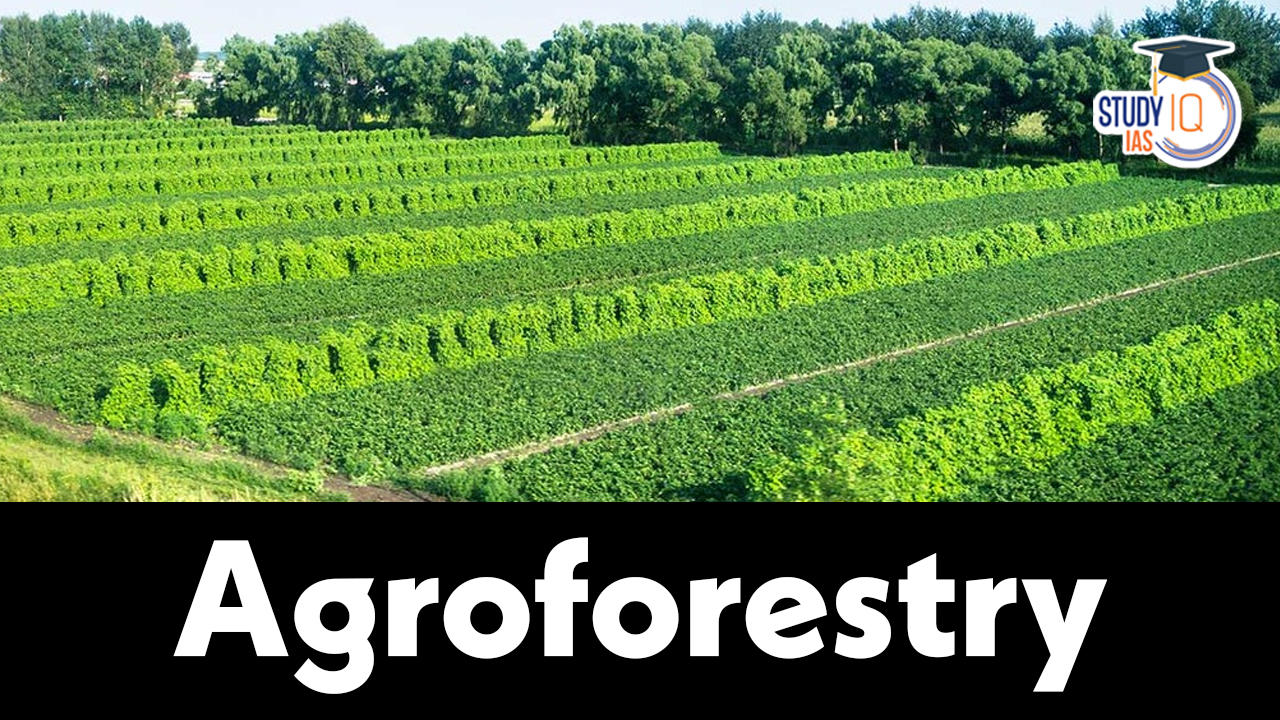Table of Contents
Context: Ministry of Environment, Forest and Climate Change (MoEFCC) has released a factsheet on agroforestry listing 36 species that can be grown in different agro-climatic zones.
More on the News
- As per the factsheet:
- Trees suitable for rainfed areas: Azadirachta indica, Pongamia pinnata, Ailanthus excelsa, Albizia lebbeck, Hardwickia binata, Pterocarpus marsupium, Pterocarpus santalinus, Santalum album, Syzygium cumini, Acacia nilotica, Acacia leucophloea, Ziziphus jujuba.
- Tree crops suited for saline / sodic lands: Eucalyptus, Casuarina, Pongamia pinnata, Azadirachta indica, Pithecellobium dulce, Salvadora oleoides, Salvadora persica, Capparis decidua, Terminalia arjuna, Cordia rothii, Albizia lebbeck, Pongamia pinnata, Sesbania sesban, Butea monosperma and Acacia leucophloea.
- Trees suitable for waterlogged areas: Syzygium cuminii, Pongamia pinnata, Michelia champaca, Terminalia arjuna, Holoptelea integrifolia, Thespesia populnea, Acacia nilotica, Calophyllum inophyllum, Lannea coromandelica, Casuarina and Eucalypts.
- The factsheet also listed State-wise List of Potential tree species for Agroforestry.
What is Agroforestry?
- Agroforestry is the collective term given to land-use systems and technologies in which woody plants are used on the same land-management units as agricultural crops and/or animals.
- Agroforestry includes both ecological and economical interactions between the different components.
- Major attributes of agroforestry systems:
- Productivity: production of preferred goods and increasing productivity of the land resources
- Sustainability: conserving the production potential of the resource base
- Adoptability: acceptance of the prescribed practice by the users or in line with existing regional practices
Types of Agroforestry
There are three main types of agroforestry systems:
- Agrisilviculturalsystems are a combination of crops and trees, such as alley cropping or home gardens.
- Silvopastoral systems combine forestry and grazing of domesticated animals on pastures, rangelands, or on-farm.
- The three elements, namely trees, animals, and crops, can be integrated into what is called agrosilvopastoral systems and are illustrated by home gardens involving animals as well as scattered trees on croplands used for grazing after harvests.
Agroforestry in India
- Spread: Currently, agroforestry is practiced on 13.5 million hectares in India. About 65 per cent of the country’s timber and almost half of its fuel wood come from trees grown on farms.
- Employment: Agroforestry is currently generating 450 employment-days per hectare per year in India.
- Forest cover: The forest cover in India has grown from 21% to 25%. This 4% growth has been contributed by agroforestry in recent years.
Advantages of Agroforestry
- Reduces pressure on forests: Agroforestry will perform most of the functions of traditional forests, including fulfilling timber needs. This will reduce pressure on forests.
- Recycling of nutrients: Agroforestry will help better manage nutrient cycle of the unit. Waste generated from one component can act as nutrient for another component.
- Support biodiversity: Agroforestry supports greater range of biodiversity over conventional systems. This is because of variety in microclimate.
- Protect soil: Trees grown on the land will protect top layer of soil, preventing erosion due to water or wind. This will conserve soil nutrients.
- Income augmentation: Agroforestry provides opportunity for income augmentation, thereby reducing pressure on farming.
- Carbon sinks: Forests act as carbon sinks. Agroforestry will act as artificial forests and can perform carbon storing functions.
- Pollution control: Agroforestry helps in reducing dust, particulate matter as well as odour. It improves quality of air, soil and water.
Challenges for Agroforestry
- Lack of Knowledge and training: Agroforestry is a specialized field that requires certain amount of knowledge in order to reap benefits.
- Long term benefits: Agroforestry will start providing profits on the longer run. In short run, profits may decline due to reduction in cropping area.
- Stringent forest laws: Indian forest laws are very stringent that prevents landowner from cutting trees grown on his/her land without multiple permissions.
- Food security: Diverting agricultural land from cereal and commercial crops may create a scarcity of food and industrial raw material.
- Lack of dedicated agency: Most of the countries, including India, do not have a dedicated agency to promote agroforestry in the country.
- Other constraints faced by the farmers while adopting agroforestry:
- Trees interfering with agricultural crop yield,
- Increased crop damage from birds that trees attract and the pests that use trees as alternate hosts,
- Release of some allelochemicals from some tree leaves that have an allelopathic effect on crop productivity,
- Lack of market mechanisms for tree produce, and
- Dearth of remuneration for undertaking tree cultivation under agroforestry systems.
Government Initiatives to Promote Agroforestry
- Since the 1970s, India has promoted research in the field of agroforestry.
- India is the first country to develop and adopt an agroforestry policy – the National Agroforestry Policy (NAP).
- The policy was announced by the Indian government in 2014 at the World Congress on Agroforestry in New Delhi, becoming the world’s first nation to establish an agroforestry policy.
- The policy contains framework to address growth of agricultural livelihoods and minimizing climate change by boosting agricultural production.
- Goals under the policy:
- Creation of a national nodal body to bring together various agroforestry projects, programmes, and policies of the government.
- Using agroforestry techniques to improve economic situation of small farmers.
- Protection of environment and addressing the growing demand for wood and other agroforestry commodities.
- Expanding India’s forest cover through agroforestry.
- The policy also aims to reduce import of wood and wood products to save foreign exchange.
- A Sub-Mission on Agroforestry (SMAF) under National Mission for Sustainable Agriculture (NMSA) was initiated by the Department of Agriculture, Cooperation & Farmers Welfare in 2016.
- The aim of the submission was to expand the tree coverage on farmland complementary with agricultural crops.
- The “Har Medh Par Ped” scheme was launched in 2016-17 to encourage tree plantation on farmland along with crops/ cropping systems to help the farmers get additional income and make their farming system more climate resilient and adaptive.
Way Forward
- Financial backing and promotion: The concept of agroforestry needs to be financially backed and promoted with more zeal. Proper training and information should be given to the farmers for them to adopt the method scientifically.
- Capacity building: Farmer collectives like cooperatives, self-help groups, Farmer -Producer Organisations (FPOs) must be promoted for building capacities to foster the expansion of tree-based farming and value chain development.
- Policy integration: Policymakers should incorporate agroforestry in all policies relating to land use and natural resource management and encourage government investments in agroforestry-related infrastructure.
- MoEFCC’ s Factsheet has suggested the following measures to scale up agroforestry in India:
- Development of new agroforestry models for different agro-climatic zones.
- Ensuring the availability of certified planting material to the farmers and other users.
- Participatory research on larger agroforestry models viable across different agroecological regions.
- Developing ideotypes (specific tree varieties) suitable to various agroforestry systems.
- Development of industries and/or secondary processing units near the agro forestry zones.
- Introducing innovative technologies for an efficient and well managed agroforestry system.
- Improving market access to farmers and incentivizing value-added agroforestry.
- Research on ecological and social impacts on adoption of agroforestry.
- Decision Support Systems for the selection and management of species in agroforestry systems.
- Improve the delivery of technology know-hows to the farmers through extension programmes involving research institutions and industries.


 List Of Tribal Festivals In India
List Of Tribal Festivals In India
 UKPSC Exam Date 2024, Check PCS Notifica...
UKPSC Exam Date 2024, Check PCS Notifica...
 Combined Medical Services Examination, 2...
Combined Medical Services Examination, 2...

















